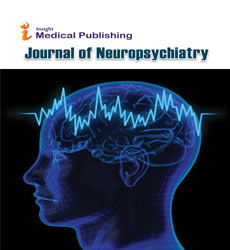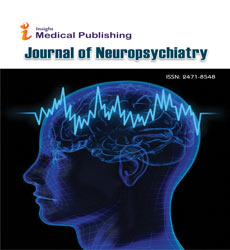Editorial on Pathogenesis and Treatment Strategies for Central Neurocytoma
Xu-Lin Liao*
Xu-Lin Liao*
Department of Neuropsychiatry, University of Birmingham and BSMHFT, Birmingham, UK
- *Corresponding Author:
- Xu-Lin Liiao
Department of Neuropsychiatry
University of Birmingham and BSMHFT
Birmingham, UK
E-mail: liaoxuklin@gmail.com
Received Date: Sebtember 8, 2021; Accepted Date: September 22, 2021; Published Date: September 29, 2021
Citation: Liao XL (2021) Editorial on Pathogenesis and Treatment Strategies for Central Neurocytoma. J Neuropsychiatry Vol.5 No.1:e001
Description
Primary neurocytomas are uncommon intraventricular neoplasms of the important frightened gadget, compromising zero.25-0.5% of brain tumors. The analysis and management of those tumors remains debatable because maximum clinical series are small. Normally, sufferers with critical neurocytomas have a positive diagnosis, but in a few cases the scientific route is extra aggressive. Even though histological functions of anaplasia do not are expecting biologic conduct, proliferation markers along with mib-1 are probably more beneficial in predicting relapse. The most critical healing modality is surgical operation, and a secure maximal resection confers the pleasant lengthy-time period outcome.
Significant Neurocytoma (CN) is an extraordinary ventricular tumor; ultimately, cn has become a definitive medical and pathologic entity based on information describing its scientific, radiologic, and histopathologic characteristics. Of the sufferers tormented by cn, 70.0% are elderly between 20 and forty years, and its occurrence does now not show any sex preponderance. About 25.0% of the tumors are “unusual cns”; these are extra competitive and are characterised through a ki-sixty seven index > 2.0–3.0%, and they'll have infiltrative margins, better degrees of mitotic pastime, nuclear atypia, necrosis, and vascular proliferation.
At present, surgical treatment is the mainstay of cn remedy. A few researchers remember that the tumor's resection variety is the most important prognostic element, and that complete resection of cn should reap better manage of nearby tumor recurrence; but, the correlation among total tumor resection and average survival (os) remains controversial. In addition, furthermore, adjuvant radiotherapy does no longer improve sufferers' karnof skyperormance reput e (kp s) r ankings after entire tumor resection and whether or not it is vital after whole resection of cn remains controversial. Hence, the administration of radiotherapy to treat cn requires a complete assessment.
In view of the lack of readability about cn treatment, we examined the survival, complications, and the lengthy-term purposeful reputation of sufferers with cn following treatment to determine whether adjuvant radiotherapy after whole resection is required, whether or not incomplete resection and adjuvant radiotherapy could update whole resection given the difficulties and disabilities sufferers revel in following entire tumor resection, a nd whether o r n ot extra remedy i s wanted after the complete resection of atypical cns.
Sixty-seven sufferers had been diagnosed with global health employer (who) grade ii cn through 3 pathologists. The median fee of ki-67 became 5.0%, ranged from 1.0 to 20.0%. There were 10 cases of necrosis, 7 instances of better ranges of mitotic hobby ( ≥ 3 mitoses/10 high power fields), 2 cases of vascular proliferation and 1 case of nuclear atypia. Fifty-one patients have been recognized with bizarre cn. 16 cases have been gfap wonderful.
All patients underwent surgical procedure; the suprafrontal sulcus approach became used for 62 sufferers (62/67, ninety two.5%) and the transcallosal approach became used for 5. Fiftyfive patients (82.1%) underwent complete and 12 patients (17.Nine %) underwent incomplete resections.
Tumour shrinkage turned into visible in all cases. The volume measured earlier than radiosurgery ranged from six hundred cm3 to 5900 mm3. In the follow up period the volumes of the tumours inside the lateral ventricles reduced and ranged from 250 mm3 to 3100 mm3. In a single patient the tumour nodule in the 0.33 venticle had nearly vanished with the aid of 2 years. Calculation of the percentile modifications of the tumour volumes gave a lower.
In a gradual developing tumour tissue with a low mitotic frequency as in significant neurocytomas, the impact of radiosurgery is generally concept to be frequently vascular damage to tumour vessels resulting in tumour necrosis. The other impact seems to be direct harm to the tumour tissue itself, as proven by means of histological examination.31central neurocytomas have correct vascularisation; therefore they demonstrate a robust contrast enhancement. This vascularisation appears to be accountable for the high-quality reaction of central neurocytomas to gkrs.
The benefit of a focused radiation is that a excessive dose with a steep fall off in radiation can be delivered exactly in one singe remedy consultation. Similarly, the recurrent valuable neurocytomas are typically characterised by way of intraventricular boom, so that they tend to be surrounded with the aid of csf, and handiest a small a part of the tumour has contact with the brain tissue. This makes them ideal objectives for gkrs, as maximum of the dose surplus hits the csf and the radiation burden to the neighbouring brain tissue may be kept at a minimal. On this way, the aspect effects of radiosurgery are minimised.

Open Access Journals
- Aquaculture & Veterinary Science
- Chemistry & Chemical Sciences
- Clinical Sciences
- Engineering
- General Science
- Genetics & Molecular Biology
- Health Care & Nursing
- Immunology & Microbiology
- Materials Science
- Mathematics & Physics
- Medical Sciences
- Neurology & Psychiatry
- Oncology & Cancer Science
- Pharmaceutical Sciences
